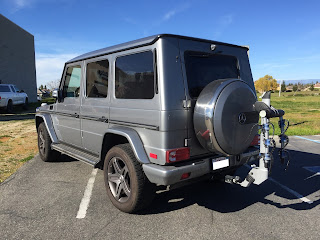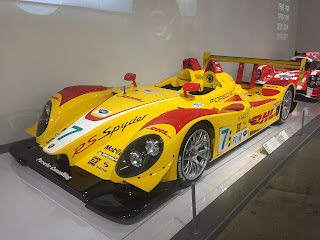Wednesday, May 29, 2019
1939 Porsche Type 64 60K10
The Type 64 is Porsche's first ever production car. It contains styling elements from other upscale vehicles of its era and inspired the 356 that came after it. Powered by a flat-four making around 40 horsepower, this vehicle was crafted to compete in the 1939 Berlin-Rome endurance race but was ultimately scrapped due to the beginning of World War II. Only three Type 64s were ever made. Two of those three were restored and survive to this day, including the example above. The Type 64 is not as well-known in the automotive world but is an important car since it is the ancestor of every other Porsche in history. I am fascinated by the earliest Porsche model due to its design, rarity, and significance.
Sunday, May 26, 2019
2019 Mercedes-Benz G550
It may not look like it at first glance, but the legendary G-Wagen has been given a thorough redesign for 2019. The new model has improved on many of the previous generation's flaws but remains true to its roots. For example, the previous G-Wagen contained exposed screws in its turn signals and reflectors, but that is no longer the case with the new model. There is little to no panel gap in the new model compared to the old one. The backup camera in the new G-Wagen is hidden below its spare tire instead of being tacked on above the rear window like in the old model. The rear wiper is now at the base of the rear window covered by the spare tire instead of the top of the rear window exposed to the elements. The third brake light in the new model is integrated into the design of the car unlike the previous one, which had its third brake light mounted from inside the vehicle. Other new G-Wagen improvements consist of proper cup holders, a traditional glove box, and an electronic parking brake. Some of the flaws listed here aren't a big deal to me, but I like how Mercedes-Benz cleaned up the design of the new G-Wagen compared to the previous model.
Powering the new G550 is a 4.0-liter twin-turbo V8 making 416 horsepower and 450 lb-ft of torque. It goes from 0 to 60 mph in 5.6 seconds and offers a 9-speed automatic gearbox, replacing the 7-speed automatic in the previous model. Its interior has been modernized with the rest of the car, containing more technology and less clutter. The 2019 G550 carries a starting price of $124,500, with options and packages quickly escalating the price from there. Despite often being used as a status symbol, the Mercedes-Benz G-Wagen is one of the best SUVs currently available. Its eye-catching, go-anywhere abilities are practically unmatched. I would choose the G-Wagen over the Range Rover but have a tough time picking between the G-Wagen and the Rolls-Royce Cullinan.
Featured here are photos I took of the previous G-Wagen this year to physically compare the two models.
Tuesday, May 21, 2019
Dodge Challenger SRT Demon
When Dodge released the Challenger Hellcat and Charger Hellcat in 2015, most people thought that factory muscle cars couldn't get any crazier. That all changed with the introduction of the limited edition Challenger Demon last year. Its specs are mind-boggling: 808 horsepower (840 on 100-plus octane racing fuel) and 770 lb-ft of torque from its 6.2-liter supercharged V8, 0-60 mph in 2.3 seconds, and a 1/4-mile time of 9.65 seconds @ 140 mph, just to name a handful. It doesn't stop there. As a result of its 1/4-mile time, the Challenger Demon has been banned by the NHRA because it doesn't contain an approved cage behind the seat(s). Unlike any production vehicle before it, the Challenger Demon is capable of performing wheelies at launch. It pulls 1.8g of force under acceleration, more than any other car. The Challenger Demon is the first street car to have a TransBrake, which is used to boost launch consistency and driver reaction time at launch on the drag strip, and torque reserve, which increases supercharger revs without straining the brakes and spinning the rear tires. As you would expect from a vehicle like the Challenger Demon, it forgoes the rear seats; however, the front passenger seat is also removed, but can be added for $1. The Dodge Challenger Demon contains the biggest functional hood scoop of any production vehicle. Other production car firsts for the Challenger Demon consist of a liquid-to-air intercooler chiller system, drag radials, and drag-oriented suspension.
The Challenger Demon weighs 200 pounds less than the Challenger Hellcat. Like other Chrysler products, it features vehicle-specific graphics on its windows. In this case, the window graphics are of a Challenger Demon doing a burnout. The top-of-the-line Challenger has an Eco mode and goes faster than pretty much any other car in Eco mode. In addition to the massive hood scoop, the Challenger Demon contains two air intakes in the headlights. Dodge advises Demon owners not to drive their vehicles in wet weather, freezing temperatures, or on the highway as these conditions will wear down its drag slicks faster. Dodge also advises that Demon owners who opt for no front passenger seat do not try to install one themselves as the front passenger will not be properly protected in an accident. Drive modes exclusive to the Demon are Drag Mode and Race Cool Down Mode. Pricing for the Challenger Demon starts in the low $80,000s, with dealer markups increasing that past $100,000.
To wrap things up, the Dodge Challenger Demon is absolutely bonkers. Although I tend to prefer the Camaro and Mustang over the Challenger, the Demon's performance capabilities are out of this world. I am completely enthused and blown away by this vehicle, and I can't imagine how any automaker would be able to produce a more extreme car.
The following photos are of other modern Dodge Challenger models slotted below the Demon (R/T, R/T Scat Pack, Hellcat, R/T T/A).
Thursday, May 16, 2019
2008 Porsche RS Spyder

Subscribe to:
Comments (Atom)


























